Undergraduate Students Participate in 2020 Summer Research Program
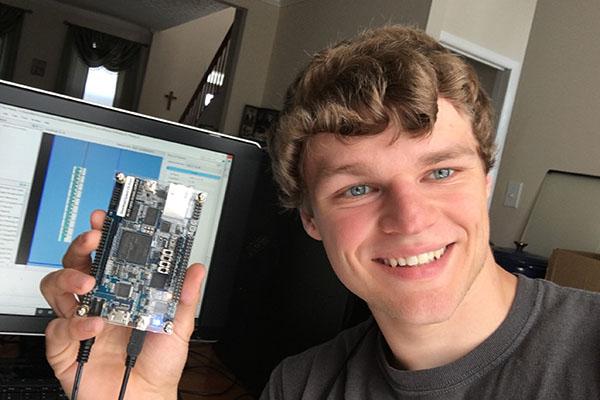
Twenty one Physics and Engineering Physics majors are participating in this summer's Undergraduate Physics Research Program, a 10-week long program designed to connect undergraduate students to the research being done by OSU physics faculty. Their research is being done remotely this summer due to the COVID-19 pandemic but that hasn't stopped them from making significant contributions and progress. We touched base with some of the students to see how things are coming along this summer.
Eliot Ferstl, working with Dr. Amy Connolly
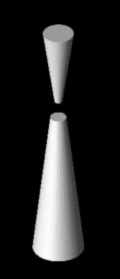
"This summer, I have had the opportunity to work with and further develop a Genetic Algorithm which evolves a Biconical Neutrino Detector Antenna. The detector will eventually be deployed in ice much like ARA, a series of bicone antennas deployed in Antarctica. They are on the search for ultra-high energy neutrino interactions in the ice. Our goal with this GA (Genetic Algorithm) is to challenge the best in-ice detectors and create a new set of neutrino detectors far better at detecting UHE neutrino interactions than those that currently exist. Before this summer, the GA had a single chromosome with three genes. This defined a symmetric bicone antenna with some length, inner radius, and opening angle. With the help of my fellow undergraduate Leo Deer, I have developed it into a GA which has two chromosomes housing four genes a piece. Each chromosome defines a length, inner radius, opening angle, and separation for one of the cones. These each could be symmetric or asymmetric across chromosomes apart from the separation which is only symmetric as the origin has no physical significance. This allows for an asymmetric bicone antenna to evolve. In short, we went from 3 evolutionary parameters to 7 evolutionary parameters. We have yet to test this updated GA heavily which will take place throughout the remainder of summer, however the results will all but certainly be positive. This is because we expect there to be more neutrino interactions below the antennas than above as a result of their relatively high location in the ice. Thus, a bicone which creates a more downward facing beam pattern will be more likely to detect a greater number of UHE neutrinos. I am looking forward to both evolving/finding results as well as continuing to add unique parameters to our antenna." Pictured left is an example antenna.
Matthew Freudenrich, working with Dr. Jay Gupta

"This summer I am modeling Spin Polarized-Scanning Tunneling Microscopy (SPSTM) images of certain magnetic structures in the program Mathematica. From my models I am developing techniques for determining characteristics of the different magnetic structures. I have focused on three different types of magnetic structures: domain walls (where the spin flips from one region to another along a boundary), spin spirals (where the spins rotate along a specific direction), and skyrmions (a magnetic quasiparticle that is closely related to spin spirals). Shown on here is a simulation of one of each type of structure.
"I’ve also spent a lot of time doing origami! As I have been stuck at home in quarantine, most of the time I am not doing my research project is spent creating origami. It has been a fun way to spend my time while stuck indoors."
Elijah Kritzell, working with Dr. Rolando Valdes Aguilar
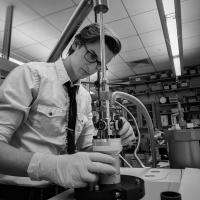
"I'm working with Dr. Valdes Aguilar in the Terahertz Group. My project is in regards to the temperature dependence of the index of refraction of the polymer material TOPAS. TOPAS has demonstrated an unusual property where the index of refraction is independent of frequency within the terahertz range, offering a multitude of potential applications within optical devices. In order to fully exploit these uses, we require knowledge of the change in refractive index with temperature. In taking this data, we have identified some additional strange behaviors which warranted further study. I spent the last school year taking the data on this further study, and developing a model to present at the APS March Meeting. Over the summer I have focused on refining the model a bit, and I am currently working to compile this model and analysis into a publication.
"Outside of summer research I haven't been involved in much due to Covid restrictions, however I am a pianist so I practice quite a bit." Pictured left is a photo of Elijah working in the lab prior to the pandemic.
Peter Menart, working with Dr. Dan Gauthier

"I am working with Caitlin Patterson to characterize the variation of signal delays through various logic elements across a cyclone V FPGA. An FPGA (Field Programmable Gate Array) is an integrated circuit that can be reconfigured using a hardware description language. Knowing how much signal delays vary across the board is useful for applications that require very precise timing, such as high resolution Time-to-Digital converters.
"I have learned how to program and debug an FPGA, and how to control the exact placement of circuit elements on the board. I have also been able to construct an array of ring oscillators on the board and use them to measure the delay for a logic element on the board." Pictured right is a photo of Peter.
Caitlin Patterson, working with Dr. Dan Gauthier

"This summer, I have been working on a project using FPGAs, which are integrated circuits that can be programmed and reconfigured by the consumer. FPGAs are affordable and can be used to create a wide variety of things, so they can be good resources in experimental physics. One thing the FPGA can be used for is to create a time-to-digital converter (TDC), which allows the user to measure the time between two incoming signals, hopefully to high resolution. Most of the progress made to this point has been toward characterizing the delay times and variation of different pieces of logic on the circuit board. This is generally helpful where timing is concerned. Moreover, we have investigated different techniques that could allow one to realize a high resolution TDC on an FPGA. Eventually, we hope to use the TDC to tag incoming photons from defects in certain materials to see if they are producing single photons. The biggest challenge has been getting more comfortable with hardware development. With the rest of my time, I’ve been working on a fun math project about braids and learning how to longboard."
Alex Patton, working with Dr. Amy Connolly
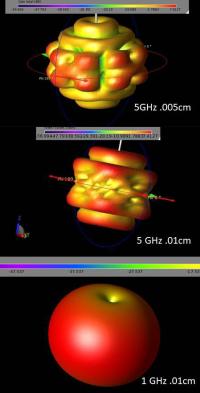
"I am working with the GENETIS group (Genetically Evolving NEuTrIno TeleScopes) and our goal is to use genetic algorithms to develop Antennas to detect Neutrinos. I've worked with this group before this program and have worked to allow individuals to run in parallel so that a generation can run within only a few hours, and earlier this year helped get our loop into a functional state.
"This summer I have been working on both improving the speed of the loop and fixing bugs found in it. I made a feature that saves a database of outputs from past runs and is able to skip rerunning dimensions that have been generated before. This is useful because in the genetic algorithm even with mutation, a few individuals tend to be direct matches from the previous generation. I initially set this database up to work with the simple Bicone antenna we have our algorithm set up with but have set it up to work with more complex designs too, as in the future we are heading towards testing more designs. Along with that feature I have also been finding and fixing some run-time bugs. This summer I have solved an issue where our software extrapolated data for smaller antennas which caused errors and outputted a zero for the fitness score and have found an error in the modeling software we use where lengths that were out of a certain range for the frequencies used would give inaccurate data and have a clamp put on the genetic algorithm to prevent it from generating below that minimum range.
"Most of my work is done on OSC (Ohio Super Computer) where I program in C++, python, and use bash scripts to work on the individual parts of the loop, but I'm going to include some of the 3D gain plots from the modeling software we use, XFdtd. At the lower frequencies the plot looks a lot like an apple and is pretty consistent in its curve but at higher frequencies the graphs look a lot more interesting and dramatic and this was used to help determine which lengths were in the accurate range because the two 5 GHz gain plots are actually of the same bicone but with the separation distance being the only difference which shouldn't have an affect in the software we use for accurate lengths."
Cade Sbrocco, working with Dr. Amy Connolly
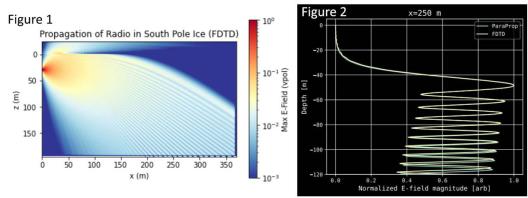
"During this summer research program, I have used finite difference time domain (FDTD) simulations to model radio propagation in Antarctic ice for the proposed Radar Echo Telescope (RET) experiment (Figure 1). These simulations, while accurate, are computationally intensive. Thus, my results are being used to vet the quicker parabolic equation (PE) simulations to answer the same questions. After exhaustive analysis of the accuracy of FDTD simulations (and comparison to literature), the results of the simulations are similar, but it is yet to be seen if the PE method is valid for this problem (Figure 2). Further investigation into the PE simulations is needed.
Figure 1: A 2d cross section of the max E-field strength received at each position from a 150 MHz cw signal transmitted 30m below the surface of ice at the South Pole.
Figure 2: A comparison of the max E-field strength between the FDTD and PE simulations at a vertical slice 250m away from the transmitter in the setup of Figure 1.
"In addition, I have been looking into the feasibility of modeling Askaryan and transition radiation, which is a known background for RET, in FDTD simulations. The results of this investigation are currently being compared against analytic models in literature."
A huge thank-you to our scholarship donors who make this program possible:
- The Bunny C. Clark Student Support Fund
- The Bunny and Thomas Clark Scholarship Endowment Fund
- The Captain Forrest R. Biard Undergraduate Research Scholarship Fund in Physics
- Dr. David C. DeMartini Endowed Fund in Physics
- Edward R. Grilly Endowed Fund in Chemistry and Physics
- James Smith Support Fund
- The Robert P. Caren Family Endowment Fund
Other 2020 summer research participants are:
- Anthony Baraona, working with Dr. Roland Kawakami
- Noah Chongsiriwatana, working with Dr. Ralf Bundschuh
- Ian Dela Cruz, working with Dr. Andrew Heckler
- Ari Josephson, working with Dr. Brian Skinner
- Liam Kerr, working with Dr. Lou DiMauro
- Zach Levy, working with Dr. Len Brillson
- Allison Lucas, working with Dr. K.K. Gan
- Brendan McHugh, working with Dr. Chris Orban
- Feng Qian, working with Dr. Dan Gauthier
- Sam Roberts, working with Dr. Antonio Boveia
- Avidaan Srivastava, working with Dr. Ezekiel Johnston-Halperin
- Zach Weinland, working with Dr. Harris Kagan
- Tingwei Yuan, working with Dr. Jay Gupta
- Xiang Zhang, working with Dr. Harris Kagan
